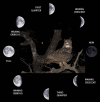Moonlight makes owls more chatty
- PMID: 20098700
- PMCID: PMC2808345
- DOI: 10.1371/journal.pone.0008696
Moonlight makes owls more chatty
Abstract
Background: Lunar cycles seem to affect many of the rhythms, temporal patterns and behaviors of living things on Earth. Ambient light is known to affect visual communication in animals, with the conspicuousness of visual signals being largely determined by the light available for reflection by the sender. Although most previous studies in this context have focused on diurnal light, moonlight should not be neglected from the perspective of visual communication among nocturnal species. We recently discovered that eagle owls Bubo bubo communicate with conspecifics using a patch of white throat plumage that is repeatedly exposed during each call and is only visible during vocal displays.
Methodology/principal findings: Here we provide evidence that this species uses moonlight to increase the conspicuousness of this visual signal during call displays. We found that call displays are directly influenced by the amount of moonlight, with silent nights being more frequent during periods with no-moonlight than moonlight. Furthermore, high numbers of calling bouts were more frequent at moonlight. Finally, call posts were located on higher positions on moonlit nights.
Conclusions/significance: Our results support the idea that moon phase affects the visual signaling behavior of this species, and provide a starting point for examination of this method of communication by nocturnal species.
Conflict of interest statement
Figures


Similar articles
-
Chronobiology by moonlight.Proc Biol Sci. 2013 Jul 3;280(1765):20123088. doi: 10.1098/rspb.2012.3088. Print 2013 Aug 22. Proc Biol Sci. 2013. PMID: 23825199 Free PMC article. Review.
-
The dusk chorus from an owl perspective: eagle owls vocalize when their white throat badge contrasts most.PLoS One. 2009;4(4):e4960. doi: 10.1371/journal.pone.0004960. Epub 2009 Apr 8. PLoS One. 2009. PMID: 19352433 Free PMC article.
-
Differential fitness effects of moonlight on plumage colour morphs in barn owls.Nat Ecol Evol. 2019 Sep;3(9):1331-1340. doi: 10.1038/s41559-019-0967-2. Epub 2019 Sep 2. Nat Ecol Evol. 2019. PMID: 31477846 Free PMC article.
-
Lunar cycle and moonlight intensity influence nocturnal migration patterns in a small songbird.Sci Rep. 2025 Jun 6;15(1):19944. doi: 10.1038/s41598-025-04270-3. Sci Rep. 2025. PMID: 40481118 Free PMC article.
-
Living in the dark does not mean a blind life: bird and mammal visual communication in dim light.Philos Trans R Soc Lond B Biol Sci. 2017 Apr 5;372(1717):20160064. doi: 10.1098/rstb.2016.0064. Philos Trans R Soc Lond B Biol Sci. 2017. PMID: 28193809 Free PMC article. Review.
Cited by
-
Chronobiology by moonlight.Proc Biol Sci. 2013 Jul 3;280(1765):20123088. doi: 10.1098/rspb.2012.3088. Print 2013 Aug 22. Proc Biol Sci. 2013. PMID: 23825199 Free PMC article. Review.
-
Achromatic Markings as Male Quality Indicators in a Crepuscular Bird.Biology (Basel). 2025 Mar 16;14(3):298. doi: 10.3390/biology14030298. Biology (Basel). 2025. PMID: 40136553 Free PMC article.
-
Melanism evolution in the cat family is influenced by intraspecific communication under low visibility.PLoS One. 2019 Dec 18;14(12):e0226136. doi: 10.1371/journal.pone.0226136. eCollection 2019. PLoS One. 2019. PMID: 31851714 Free PMC article.
-
Variations in home range and core area of red-backed voles (Myodes regulus) in response to various ecological factors.Sci Rep. 2022 Dec 23;12(1):22226. doi: 10.1038/s41598-022-26779-7. Sci Rep. 2022. PMID: 36564554 Free PMC article.
-
Nightjars may adjust breeding phenology to compensate for mismatches between moths and moonlight.Ecol Evol. 2018 Apr 27;8(11):5515-5529. doi: 10.1002/ece3.4077. eCollection 2018 Jun. Ecol Evol. 2018. PMID: 29938070 Free PMC article.
References
-
- Trillmich F, Mohren W. Effects of the lunar cycle on the Galápagos fur seal, Arctocephalus galapagoensis. Oecologia. 1981;48:85–92. - PubMed
-
- James D, Jarry G, Érard C. Effet de la lune sur la migration postnuptiale nocturne de l'alouette des champs Alauda arvensis L. en France. Compt Rendus Acad Sci, Sci Vie. 2000;323:215–224. - PubMed
-
- Naylor E. Marine animal behaviour in relation to lunar phase. Earth Moon Planets. 2001;85–86:291–302.
-
- Rahman MdS, Takemura A, Takano K. Lunar synchronization of testicular development and steroidogenesis in rabbitfish. Comp Biochem Physiol Part B. 2001;129:367–373. - PubMed
-
- Takemura A, Rahman MS, Nakamura S, Park YJ, Takano K. Lunar cycles and reproductive activity in reef fishes with particular attention to rabbitfishes. Fish and Fisheries. 2004;5:317–328.
Publication types
MeSH terms
LinkOut - more resources
Full Text Sources
Miscellaneous

